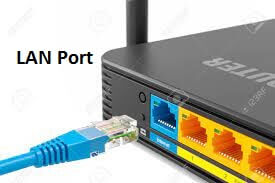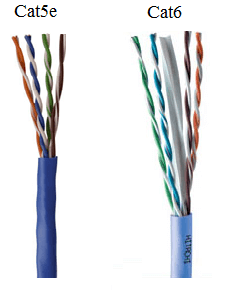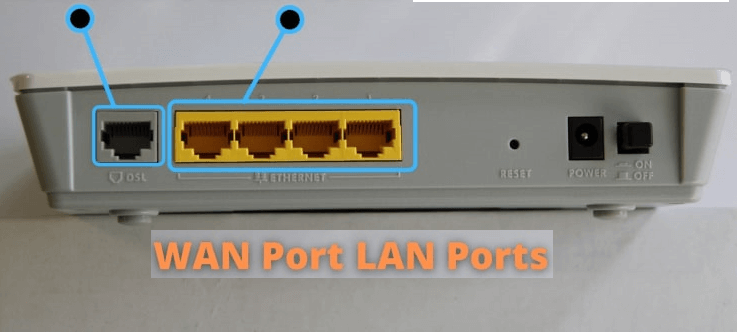What is a LAN Port?

A LAN port, also known as a network port, Ethernet port, or network connection, is a socket that allows a computer to connect to a network through a wired connection. It’s also utilised to link internet-connected video gaming consoles, servers, and other devices. In contrast to wireless connections, they are only used to establish a wired internet connection. And these ports are located on the backside of the network devices and the computers. The below picture represents how the LAN port looks.
A LAN, in contrast to WANs and MANs, is just a group of devices connected over the internet over a short distance; hence, it is abbreviated as LAN. As the port is used to establish LAN connection, such as school, office, and home networks; therefore, it gets the name LAN port. LAN ports are much wider and resemble old landline telephone jacks. This is because, while comparing with phone jack’s four or six, LAN ports have eight pins. There are various devices that contain LAN ports, such as laptops, desktop computer towers, modems, mini PCs, network switches, routers, servers, video game consoles, and Smart TVs.
How does a LAN port work?
To connect to the LAN port, you’ll need an Ethernet network cable and two Ethernet-compatible devices. The Ethernet cable is inserted into the LAN port on the device that is linked to the internet when you need to make a connection. Connect the cable to the computer using devices such as a router, gaming console, modem, or modem-router combination, and so on.
What is a LAN cable?
There are several types of LAN cables, the most prevalent of which being Cat 5e and Cat 6. Copper wiring, commonly known as Ethernet cables, is used to construct them. These lines come to a halt with a jack 45 connection. The RJ45 connection is placed into the LAN port, which is the piece of Ethernet cable at the end. Sometimes, a LAN port is referred to as an RJ45 Ethernet socket or an RJ45 port because the RJ45 connector is widely used in LANs.

The category of Ethernet cable will be dependent upon the data transfer rate that is contained by your network. The transfer rates of 10 Mbps to 100 Mbps at a maximum bandwidth of 100 MHz are supported by the lower categories, Categories 3-5. These are virtually obsolete due to developments in data bandwidth and transmission rate.
Cat 5e cable, on the other hand, can enable transmission speeds of up to 1 Gbps at 100 MHz. Cat 6 cable supports the same transfer rate as Cat 5e cable, but it has a greater maximum bandwidth of 250 MHz. Also, the transfer rate of up to 10 Gbps and 500 to 1,000 MHz are supported by cat6a cables and newer versions of it. In the modern computer networking field, the different cables Cat 5e, 6, and 6a cables play an important role.
| Cable | Maximum Transfer Rate | Maximum Bandwidth |
|---|---|---|
| Cat 5e | 1 Gbps | 100 MHz |
| Cat 6 | 1 Gbps | 250 MHz |
| Cat 6a | 10 Gbps | 500 MHz |
| Cat 7 | 10 Gbps | 600 MHz |
There is a need to attention that the cable should not belong more than 100 meters. This is because the data transfer rate will decrease if you increase the cable length to over 100 meters. You may perform an internet speed test to determine your network’s data transmission rate, which can help you choose the proper Ethernet cable for your application. Because internet service is continually expanding, it is preferable to use a Cat 5e cable or a newer version.
How does a LAN port different from an SFP port?
Both LAN port and SFP port are found on computers and network devices, but they have a key difference between both. The most explicit difference is that to create a connection, an SFP transceiver is required for SFP (small form-factor pluggable) instead of requiring an Ethernet cable. Another difference between LAN port and SFP port is distance. Ethernet cable length can only be increased before performance deteriorates due to copper wire. On the other hand, with an SFP port, without declining occur in data transfer rate, it allows to extend the fiber optic cables.
Difference between LAN ports and WAN ports

A LAN port is created on a network device or computer by connecting the RJ-45 Ethernet connector to it. A LAN port connects all of the server machines, client machines, and network devices on the client machines.
For small-scale networks such as residences or small enterprises, a WAN (Wide Area Network) port is built utilising an RJ-45 Ethernet connector. It is connected to a cable or DSL modem, which is used to connect to an external network such as the internet.
The objective of the network is the primary difference between LAN and WAN ports. The main function of WAN is to connect with a modem for an Internet source. With all devices connected to routers like mobile phones, computers, and printers, the internet is shared by LAN port.
When you are connecting a home router to the internet, you need to know the difference between these ports at that time. It’s important to remember that the WAN is necessary to connect to the modem, and the LAN socket is required to connect multiple PCs. When linked to the modem, the WAN also allows you to receive a signal from the Internet provider.
Additionally, another difference between these ports is the data transfer rate. As compared to the speed of downloading data from the internet, the speed of data transfer is higher in a local network. For instance, WAN ports have the potential to transmit data up to 100 Mbps, while LAN ports can transmit data up to 1000 Mbps. Therefore, the data can be exchanged by devices at high speed, which can be supported by network cards. The WAN limits the speed of exchange with the “outside world,” in any case.
The WAN port is always located on the router, apart from the LAN ports. Usually, the WAN port is a different color in terms of indicating the difference between the two kinds of the port. Although these two ports have different usages, a WAN port is entirely the same as a LAN port. A table is given below that contains all key points between LAN ports and WAN ports.
| Comparison | LAN port | WAN port |
|---|---|---|
| Meaning | LAN (Local area network) port uses ethernet cable or Wi-Fi to create a local network by connecting all the devices. | WAN (Wide Area Network) port uses a cable to establish a wide network by connecting all the routers. |
| Use | For all the connected devices, the LAN port offers Internet access or a file sharing facility. | For all the connected routers, WAN port offers internet access with the help of connecting with a modem or wireless broadband. |
| Speed | The higher bandwidth up to 1000 Mbps is contained by LAN ports. | As compared to LAN ports, WAN ports have Lower bandwidth up to 100 Mbps. |
| Color of Ports | Generally, the LAN port comes in yellow color. | Most often, WAN ports come in blue color. |
| Number of Ports | On the router, the number of LAN ports 4, 6, 8, and more can be seen. | Mostly, only one WAN port is found on the router. |
| Networking Devices | Token Ring, TCP/IP, Wi-Fi, Ethernet Cables, FDDI, Fiber Distributed Data Interface, etc. | Satellite, routers, modems, wireless broadband, switches, optical wires, bridges, etc. |
| Data transfer Protocols | It uses an Ethernet cable and IEEE 802.11 to transmit data. | It uses Frame Relay, HDLC, PPP protocol to transmit data. |
Which Trenton products include a LAN port?
Trenton Systems rugged servers, from the 1,000 to the 5,000 series, are equipped with two 1GbE and two 10Gbe LAN ports.
